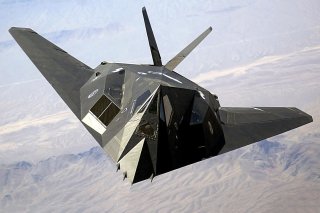How the F-117 Nighthawk Found a Second Wind After Retirement
Although there are likely no plans for the jet to enter active service anytime soon, its current mission is likely as a trainer/tester platform.
In a March 19th Instagram post, an aviation enthusiast posted several photos of an F-117 flying in Star Wars Canyon in California. The canyon, officially known as Rainbow Canyon, is frequently used by the Air Force for pilot training and is favored by aviation photographers for its favorable vantage points from which to shoot photos.
The photographer only caught a brief glimpse of the F-117. It “circled twice, then [was] gone. And about 30 minutes after, it came back the same area of the sky,” just enough to snap a couple of photographs that clearly showed the F-117’s characteristic highly-swept wings and v-shaped tail assembly.
Type 1000 Storage
Since retirement, F-117s have been kept in so-called Type 1000 storage. According to the Air Force, airframes kept in Type 1000 storage are “to be maintained until recalled to active service, should the need arise,” during times of national crisis—or if pilots need specific training, in this case likely related to the F-117’s stealth characteristics.
Airframes kept in Type 1000 storage are nearly flight-worthy. They “have a high potential to return to flying status and no parts may be removed from them.” Every four years, Type 1000 aircraft are overhauled and checked for preservation quality.
Depending on how long a plane has been in Type 1000 storage, they can be made flight-worthy in 30 to 120 days. And, in order to check if storage protocols are being correctly followed, airframes in Type 1000 storage are sometimes flown to prove their airworthiness. Some F-117 sightings might be simply test flights to prove the efficacy of their Type 1000 storage—though likely not the only reason.
Flight Training
Adding onto flight worthiness checks, some particularly well-preserved F-117s might be used to test stealth-detection ability. Testing radars with F-117s could simulate near real-world flight conditions for AWACS (Airborne Warning and Control System) radars, and could potentially be cheaper than using more modern F-22s or F-35s as testers. Ground-based radars would also benefit from training against a stealth plane.
Postscript
It is unclear how much longer F-117s will be flying for. In 2017, Congress mandated that the Air Force was to begin destroying stored F-117s, possibly only a singly bird was destroyed as a proof-of-concept exercise. Despite the Congressionally-approved destruction mandate, it appears as though relatively few F-117s are resting in boneyards, indicating they are still of some use. But how much longer they’ll have a purpose is anybody’s guess.
Caleb Larson holds a Master of Public Policy degree from the Willy Brandt School of Public Policy. He lives in Berlin and writes on U.S. and Russian foreign and defense policy, German politics, and culture.
Image: Reuters

